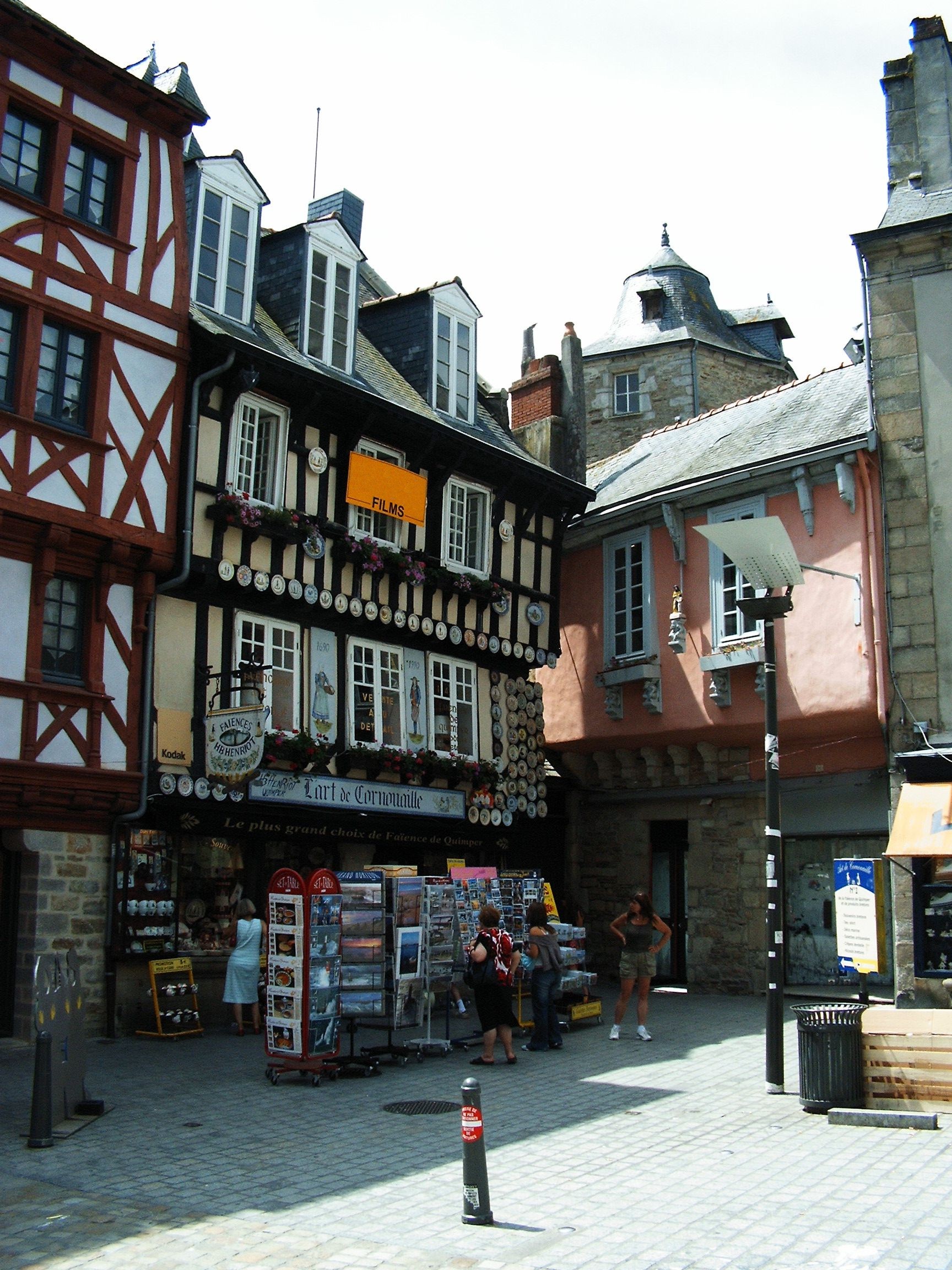|
Odet
The Odet ( br, Oded) is a river in western France (Finistère department), which runs from Saint-Goazec (near Leuhan, in the Montagnes Noires of Brittany) into the Atlantic Ocean at Bénodet. The name of the town of Bénodet comes from the river; ''ben'' means ''river mouth'' in Breton. The river runs past, or through, the towns of Bénodet, Combrit, Plomelin, Quimper, Ergué-Gabéric, Briec-de-l'Odet, Langolen, Coray, Trégourez, Leuhan and Saint-Goazec. It is long and its basin area is . The river is popular with kayakers. In 2021, an article published in the Bulletin of the French Prehistoric Society reported that archaeologists had interpreted the Saint-Bélec slab, a 4,000-year-old stone rediscovered in 2014, as a three-dimensional representation of the Odet valley. This would make the Saint-Bélec slab the oldest known map of a territory in the world. According to the authors, the map probably wasn’t used for navigation, but rather to show the political power and ... [...More Info...] [...Related Items...] OR: [Wikipedia] [Google] [Baidu] |
Saint-Bélec Slab
The Saint-Bélec slab is a stone artefact from western Brittany thought to be a map of an early Bronze Age principality. It was discovered by Paul du Châtellier in a prehistoric burial ground in Finistère, where it formed part of an early Bronze Age cist structure. Du Châtellier kept the slab at his house, the , before it came into the collection of the National Archaeological Museum. It was forgotten until 2014 when it was rediscovered in the cellar of the château. A 2017–2021 study by French and British universities and institutes identified the slab as an early Bronze Age map of part of the Odet valley. The slab is the earliest known map found in Europe and probably the earliest map of any known territory. 1900 discovery The slab was discovered in 1900 by Paul du Châtellier in a prehistoric burial ground in Finistère, western Brittany. It formed the wall of a cist burial. The cist measured long, wide and high and was orientated on an east-west alignment. I ... [...More Info...] [...Related Items...] OR: [Wikipedia] [Google] [Baidu] |
Quimper, Finistère
Quimper (, ; br, Kemper ; la, Civitas Aquilonia or ) is a commune and prefecture of the Finistère department of Brittany in northwestern France. Administration Quimper is the prefecture (capital) of the Finistère department. Geography The city was built on the confluence of the Steir, Odet and Jet rivers. Route National 165, D785, D765 and D783 were constructed to intersect here, northwest of Lorient, west of Rennes, and west-southwest of Paris. Climate Quimper has a oceanic climate (Köppen climate classification ''Cfb''). The average annual temperature in Quimper is . The average annual rainfall is with December as the wettest month. The temperatures are highest on average in August, at around , and lowest in February, at around . The highest temperature ever recorded in Quimper was on 30 June 1976; the coldest temperature ever recorded was on 13 January 1987. Etymology The name ''Quimper'' comes from the Breton ''kemper'', meaning "confluent". History ... [...More Info...] [...Related Items...] OR: [Wikipedia] [Google] [Baidu] |
Hayley Williams
Hayley Nichole Williams (born December 27, 1988) is an American singer, songwriter, musician, and businesswoman who is best known as the lead vocalist, primary songwriter, and keyboardist of the rock band Paramore. Born and raised in Mississippi, Williams moved to Franklin, Tennessee, at the age of 13 in 2002 to escape her stepfather at the time. In 2004, she formed Paramore alongside Josh Farro, Zac Farro, and Jeremy Davis. The band currently consists of Hayley Williams, Zac Farro and Taylor York. The band has released five studio albums: '' All We Know Is Falling'' (2005), '' Riot!'' (2007), '' Brand New Eyes'' (2009), '' Paramore'' (2013), and '' After Laughter'' (2017). Williams released her debut solo single, " Simmer", on January 22, 2020, and announced on the same day that her debut studio album, '' Petals for Armor'', would be released on May 8, 2020. The album was preceded by two EPs entitled '' Petals for Armor I'' and '' II'' that make up the first two-thir ... [...More Info...] [...Related Items...] OR: [Wikipedia] [Google] [Baidu] |
Early World Maps
The earliest known world maps date to classical antiquity, the oldest examples of the 6th to 5th centuries BCE still based on the flat Earth paradigm. World maps assuming a spherical Earth first appear in the Hellenistic period. The developments of Greek geography during this time, notably by Eratosthenes and Posidonius culminated in the Roman era, with Ptolemy's world map (2nd century CE), which would remain authoritative throughout the Middle Ages. Since Ptolemy, knowledge of the approximate size of the Earth allowed cartographers to estimate the extent of their geographical knowledge, and to indicate parts of the planet known to exist but not yet explored as ''terra incognita''. With the Age of Discovery, during the 15th to 18th centuries, world maps became increasingly accurate; exploration of Antarctica, Australia, and the interior of Africa by western mapmakers was left to the 19th and early 20th century. Antiquity Bronze Age “Saint-Bélec slab” The Saint-Bélec sla ... [...More Info...] [...Related Items...] OR: [Wikipedia] [Google] [Baidu] |
Bénodet
Bénodet (; Breton: ''Benoded'') is a commune in the Finistère department and administrative region of Brittany in north-western France. INSEE It lies about 16 kilometres south of Quimper. The Breton name Benoded means " mouth of the ". Bénodet has a , a |
Rivers Of France
This is a list of rivers that are at least partially in France. The rivers are grouped by sea or ocean. The rivers flowing into the sea are sorted along the coast. Rivers flowing into other rivers are listed by the rivers they flow into. Some rivers (e.g. Sûre/Sauer) do not flow through France themselves, but they are mentioned for having French tributaries. They are given in ''italics''. For clarity, only rivers that are longer than 50 km (or have longer tributaries) are shown. In French, rivers are traditionally classified either as ''fleuves'' when they flow into the sea (or into a desert or lake), or as ''rivières'' when they flow into another river. The ''fleuves'' are shown in bold. For an alphabetical overview of rivers of France, see the category Rivers of France. Tributary list North Sea The rivers in this section are sorted north-east (Netherlands) to south-west (Calais). * Rhine/Rhin (main branch at Hook of Holland, Netherlands) ** Moselle (in Koblenz, Germ ... [...More Info...] [...Related Items...] OR: [Wikipedia] [Google] [Baidu] |
Plomelin
Plomelin (; ''Ploveilh'' in Breton) is a commune in the Finistère department of Brittany in north-western France. It lies near the Odet river, about southwest of Quimper. International relations Plomelin is twinned with the village of Crymych in Wales and the village of in Germany. Population Inhabitants of Plomelin are called in French ''Plomelinois''. Breton language The municipality launched a linguistic plan concerning the Breton language through Ya d'ar brezhoneg on 3 July 2008. See also *Communes of the Finistère department The following is a list of the 277 communes of the Finistère department of France. The communes cooperate in the following intercommunalities (as of 2022):Buckwheat whisky, produced in Plomelin by ''Distillerie des Menhirs''.
|
Briec-de-l'Odet
Briec (, formerly ''Briec-de-l'Odet''; br, Brieg) is a commune in the Finistère department in the region of Brittany in north-western France. Sights * Calvary at Saint-Vennec, (1556) *Chapelle de la Madeleine, 16th century *Chapelle de Sainte-Cécile 16th century *Chapelle Notre-Dame d'Illijour 19th century *Chapelle Saint-Corentin 16th century *Chapelle Saint-Égarec 16th century *Chapelle Saint-Sébastien 16th century *Chapelle Saint-Venec 16th century *Saint-Pierre parish church, 15th century List of mayors *Jean-Hubert Pétillon 2014 *Jean-Paul Le Pann 2001/2014 *Joseph Bernard 1989/2001 *François Rolland 1981/1989 *Pierre Stephan 1959/1981 *Yves Le Page 1945/1959 *Jean Pennarun 1941/1945 *Hervé Merour 1929/1941 *Pierre Kerbourc'h 1925/1929 *Jean Pennarun 1919/1925 *Michel Croissant 1908/1919 *Jean Pennarun 1906/1908 *Michel Croissant 1904/1906 *Hervé Le Gac 1882/1904 *Pierre Dandurand 1878/1882 *Jean Bozec 1857/1878 *Jean Rolland 1855/1857 *Jean Kerbourch 1848/1855 *Her ... [...More Info...] [...Related Items...] OR: [Wikipedia] [Google] [Baidu] |
Ergué-Gabéric
Ergué-Gabéric (; ''An Erge Vras'' in Breton) is a commune in the Finistère department of Brittany in north-western France. It lies on the Odet river. The businessman and publisher Gwenn-Aël Bolloré was born in the commune. Population International relations It is twinned with Stratton, Cornwall. Sights The church of Saint Gwenhael has a 17th century organ by Thomas Dallam II and his son Toussaint. Breton language In 2008, 6.62% of primary-school children attended bilingual schools, where Breton language is taught alongside French. Twinning Ergue-Gaberic is twinned with Bude–Stratton in Cornwall, England. See also *Communes of the Finistère department The following is a list of the 277 communes of the Finistère department of France. The communes cooperate in the following intercommunalities (as of 2022): [...More Info...] [...Related Items...] OR: [Wikipedia] [Google] [Baidu] |
Coray, Finistère
Coray (; br, Kore) is a commune in the Finistère department of Brittany in north-western France. It lies on the river Odet. Geography Climate Coray has a oceanic climate (Köppen climate classification ''Cfb''). The average annual temperature in Coray is . The average annual rainfall is with January as the wettest month. The temperatures are highest on average in August, at around , and lowest in January, at around . The highest temperature ever recorded in Coray was on 9 August 2003; the coldest temperature ever recorded was on 2 January 1997. Population Inhabitants of Coray are called in French ''Corayens''. Map See also *Communes of the Finistère department The following is a list of the 277 communes of the Finistère department of France. The communes cooperate in the following intercommunalities (as of 2022): [...More Info...] [...Related Items...] OR: [Wikipedia] [Google] [Baidu] |
Combrit
Combrit () is a commune in the Finistère department of Brittany in north-western France. Artists such as Lucien Simon Lucien Joseph Simon (1861 – 1945) was a French painter and teacher born in Paris. Early life and education Simon was born in Paris. After graduating from the Lycée Louis-le-Grand, he studied painting at the studio of Jules Didier, then from ... and Alfred Marzin painted many pictures of the area. Population Inhabitants of Combrit are called in French language, French ''Combritois''. Breton language The municipality launched a linguistic plan concerning the Breton language through Ya d'ar brezhoneg on May 29, 2008. Sights *Parc botanique de Cornouaille See also *Communes of the Finistère department References External links Official website *Mayors of Finistère Association Communes of Finistère {{Finistère-geo-stub ... [...More Info...] [...Related Items...] OR: [Wikipedia] [Google] [Baidu] |
Bronze Age
The Bronze Age is a historic period, lasting approximately from 3300 BC to 1200 BC, characterized by the use of bronze, the presence of writing in some areas, and other early features of urban civilization. The Bronze Age is the second principal period of the three-age system proposed in 1836 by Christian Jürgensen Thomsen for classifying and studying ancient societies and history. An ancient civilization is deemed to be part of the Bronze Age because it either produced bronze by smelting its own copper and alloying it with tin, arsenic, or other metals, or traded other items for bronze from production areas elsewhere. Bronze is harder and more durable than the other metals available at the time, allowing Bronze Age civilizations to gain a technological advantage. While terrestrial iron is naturally abundant, the higher temperature required for smelting, , in addition to the greater difficulty of working with the metal, placed it out of reach of common use until the end of ... [...More Info...] [...Related Items...] OR: [Wikipedia] [Google] [Baidu] |




